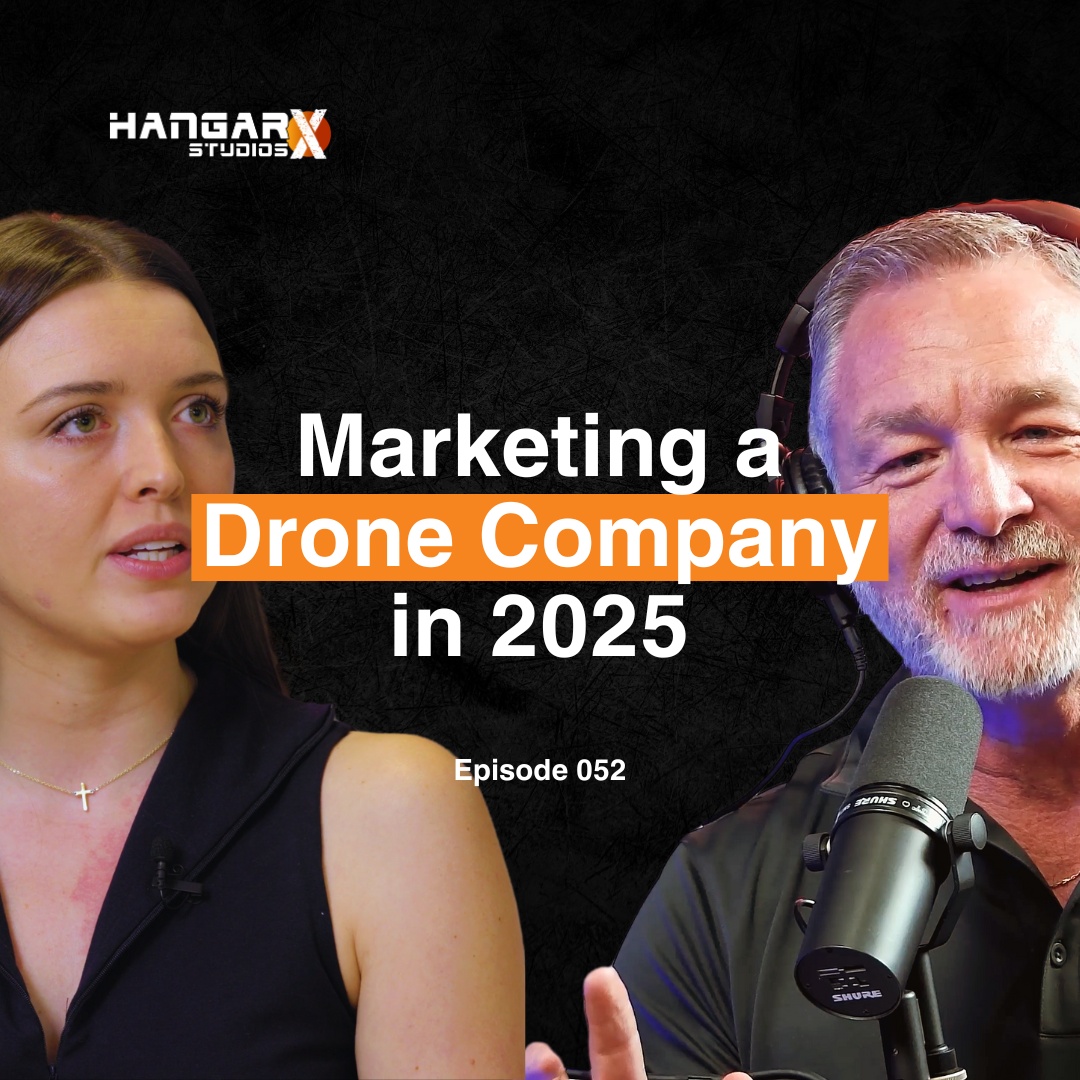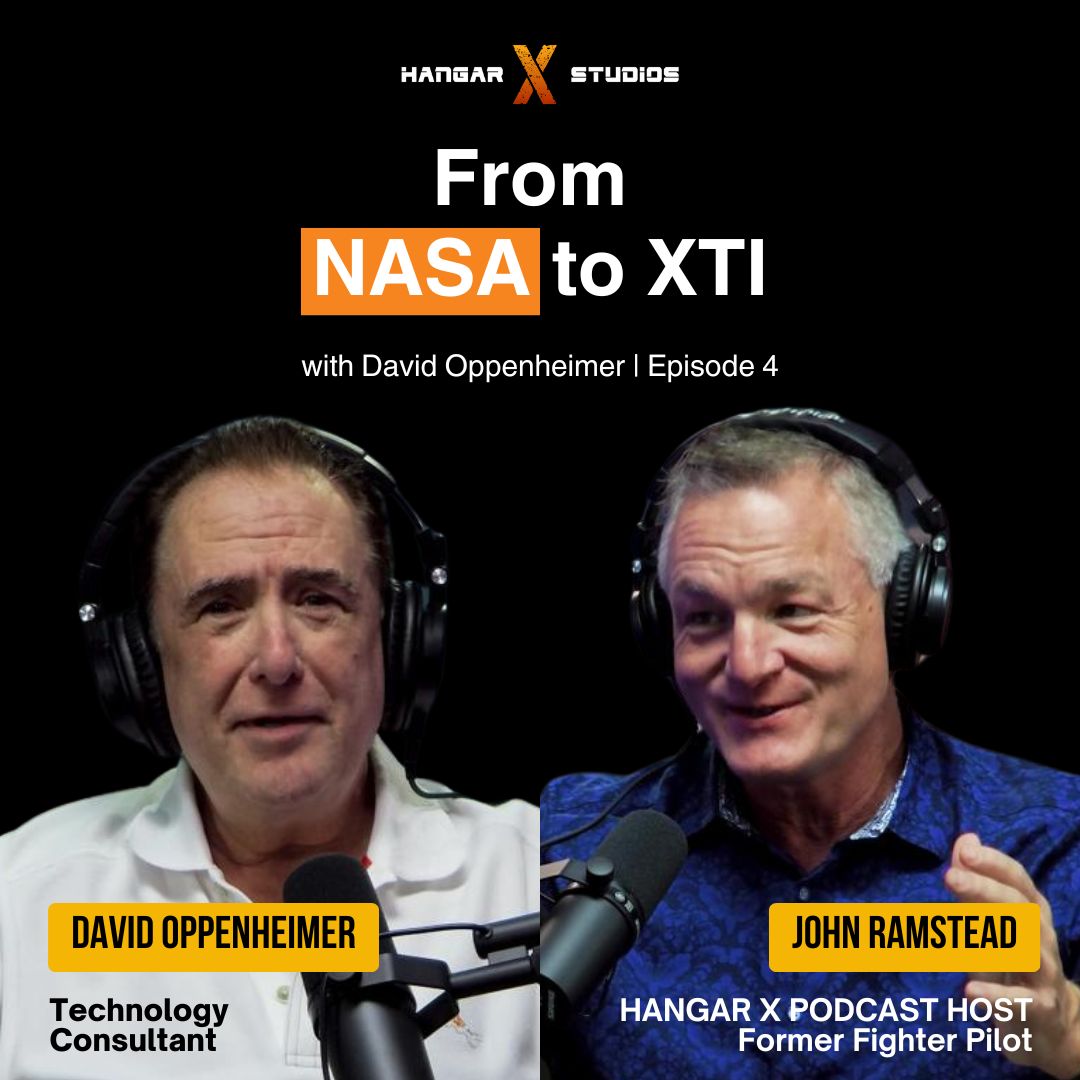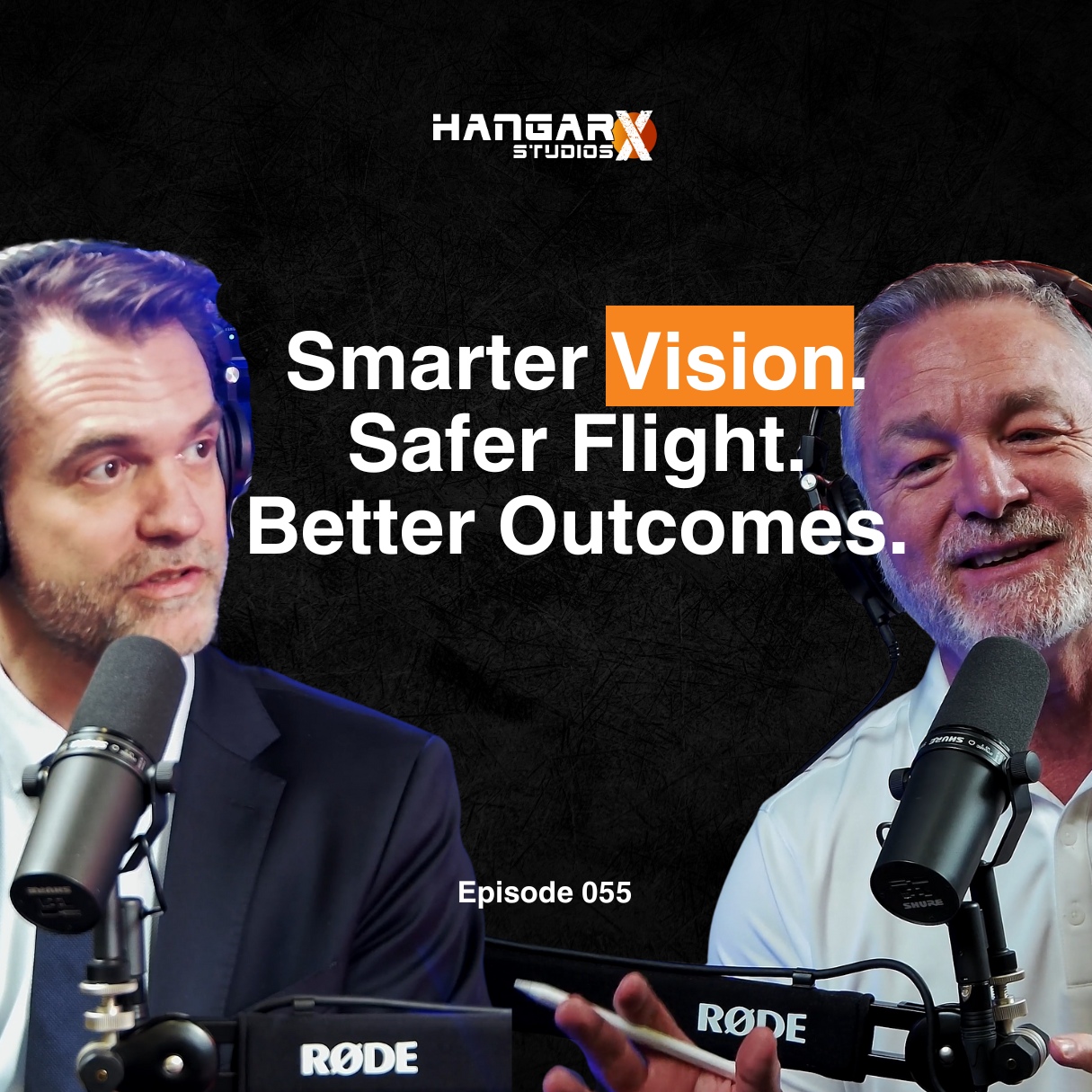[00:00:03] Rob Bentley Johnston: We're a little bit tougher down there, so they didn't give us a 9 mil, they just gave us a long knife. So from Alice Springs, going across to the top part of broome, it's about 400 nautical miles with nothing. And yeah, you gotta take some water and a big knife. That's it.
Welcome to Hangar X Studios where former fighter pilot and host John Ramstead takes us on a journey across aerospace and as it enters an historic period of innovation and transformation.
Our guests include aviation experts, pilots, financiers, military leaders and innovators of all types.
Buckle up for another episode of Hangar X.
[00:00:50] John Ramstead: Today's episode is brought to you by our platinum sponsor and XTI Aerospace. They are powering the vertical economy, building a long range VTOL and you can find
[email protected] now please remember to like, comment and share on this channel and enjoy today's podcast. Welcome to the Hangar X Studios and we are live at Verticon and this is the place where disruptors and innovators and thought leaders across vertical aviation are coming and we're going to get to hear the news before the rest of the world. And today we have on Rob Bentley Johnson. Rob, first of all, welcome to the podcast.
[00:01:28] Rob Bentley Johnston: Great to be here. Thanks for having us.
[00:01:30] John Ramstead: And you're with Hellaflight Australia and I've been to Australia with the military a number of times with the Sydney in Perth and Darwin and I got some interesting stories about Darwin. But first of all, I'd love to hear about kind of hella flight and what is happening in the helicopter world across Australia because you guys are really have your finger on the pulse there.
[00:01:49] Rob Bentley Johnston: Definitely, that is, that's our key market and where I've been working for 15 years in that particular space. So myself I've come from a flightline background.
So Heliflight, we've been distributors for Robinson helicopters for nearly 50 years.
One of the first dealers in the world and where we see the market in aviation, that vertical platform, something that we've been cross for that period in detail. So my 15 years of experience within the company itself, along with time and aviation before that. So to give a quick background of the few thousand hours I've got, that's from a flight training side. Again, flying across Australia.
I'm keen to hear your horse stories and how that integrates with flying across Australia with maybe some legal or illegal items on board.
Thankfully all of mine have been legal. I can admit that here in this public space.
[00:02:38] John Ramstead: Fixed wing or helicopter or both?
[00:02:40] Rob Bentley Johnston: All fixed wing That's. Sorry, Chris. All helicopter. I've never had any desire to get into the fixed wing space. It's always been helicopter for me from the beginning, which, that's one of the areas that we're interested to expand in how the longer range fixed wing component will link in with that vertical component too. So that's a space that we're excited about.
[00:03:02] John Ramstead: And you know, we just had David Smith on the CEO of Robinson. It was a fascinating interview, especially talking about kind of their vision. But I got to tell you the quick story of Darwin. We were actually going into the Persian Gulf and we were going to go do a bilateral exercise in the Darwin Ranges with the Royal Australian Air Force. And they tell us we had to pack a 9 millimeter pistol to fly over Darwin because if we eject everything up, there's no human. So if you eject everything, you're a food source. And they said if.
So they said if you eject, go find a rock, put your back against the rock, pull out your pistol and wait for the helicopter to come. Ed I thought they were kidding. I thought they were just like trying to make. Well, the next day I go put on my flight gear and go down to the paraloft and they were there issuing handgun. It was the first time I ever flew with a handgun in my survival kit. Those three days doing those exercises over Darwin. But it's kind of. That's remote country up there.
[00:03:53] Rob Bentley Johnston: It is. I can relate to that.
We're a little bit tougher down there. So they didn't give us a 9 mil. They just gave us a long knife. So from Alice Springs, going across to the top part of broome, it's about 400 nautical miles with nothing.
And yeah, you gotta take some water and a big knife. That's it.
[00:04:13] John Ramstead: Water and a big knife. You guys are tougher than us.
[00:04:15] Rob Bentley Johnston: Always.
[00:04:17] John Ramstead: Always. That's right now. So Heliflight, you're a distributor, Robinson, but what else are the. What are you doing across Australia?
[00:04:23] Rob Bentley Johnston: So the other platforms we're looking at, as you're saying, David Smith and Robinson, we're working closely with them on some of the other directions. They're heading into that vertical space. So they've acquired ascent drone systems and that's an area that we've got interest in as well. So we really want to be the market leaders from to the 250 gram category all the way through up into wherever, however big it wants to get. We're willing to get there.
[00:04:46] John Ramstead: Yeah, you know, in the Australian market, you know, VTOL EVTOL is really taken off here. There's a lot of now entrants coming into verticon. It's more than just helicopters now. What are you seeing in the Australian market as far as it comes to EVTOLs? You know VTOL's more what we call Exvitol that extended range VTOL that maybe out to 800 miles from you know, 100 to 800 miles. What are your thoughts on that?
[00:05:09] Rob Bentley Johnston: That's, that's the interest. That's the space we're most interested in is that X, that longer range. Our urban dynamics and our geo.
The economic state of our cities is very different to the economic states of the usa. So what I mean by that is our wealth is more dispersed on, on a 500 nautical mile range rather than a 90 mile range. So an example of that be downtown LA can get. It can take you three hours to cross town for us in Sydney for example with high net worth individuals you can still get around most of the city within an hour. And all of that wealth is usually centralized to the CBD area, the central business district. So if you're within, if you're one of those high net worth individuals that needs to travel a lot and your time's critical, you're most likely already within half an hour of your end destination.
[00:05:59] John Ramstead: If your destination is in the city.
[00:06:01] Rob Bentley Johnston: If your destination the city. So like our urban air mobility market will take longer to mature. That's my decision because there's not as.
[00:06:09] John Ramstead: Much demand, it's not as much but that regional the reason different that's much.
[00:06:13] Rob Bentley Johnston: More, that's much more interesting to us. So we understand that between the fixed wings and the helicopters we can do most of the urban stuff already in the helicopter. But what we can't do well is or what we're looking to improve on is getting the urban region to region connections and that end to end user rather than at the moment we've got a message potentially fly from. You've got to go from a location an hour out of Sydney down to the airport, jump a jet, go out to say Bathurst, Newcastle, Wollongong and then go another half an hour to your destination.
[00:06:41] John Ramstead: What are the distances of those cities to Sydney?
[00:06:44] Rob Bentley Johnston: Yeah. To give you a bit of comparison. So I'll talk in nautical miles to make it a bit more easier for our market. But you're looking anywhere from say as little as 100 nautical miles out to around the 400 nautical mile marks. Okay. And that's where we have a high concentration of mining sector a lot of tech as well. So we want to try and connect a lot of those regional areas and those regional hubs with as little time in transit between each of them.
[00:07:12] John Ramstead: What is for a helicopter, what is a range? 100, 200 miles. Like where's the extent of like that starts to get a little uncomfortable.
[00:07:19] Rob Bentley Johnston: Yeah.
[00:07:19] John Ramstead: Because of the speed and the time.
[00:07:20] Rob Bentley Johnston: Particularly if you've got an executive on board. 200 nautical miles is a comfortable distance.
[00:07:24] John Ramstead: Okay.
[00:07:25] Rob Bentley Johnston: If they're a bit more aviation savvy, 400 nautical miles of the fuel stop halfway, that type of thing. Or some of those larger aircraft. Yeah. You'll push out to sort of 3, 350.
But you've also got to think of the end user and if we can bring that time, the distance on XVTOL.
[00:07:40] John Ramstead: Most of them are 2 to 3x the speed of the average helicopter.
[00:07:44] Rob Bentley Johnston: Exactly. That's. And that's where we see it.
[00:07:46] John Ramstead: And take off from the same place.
[00:07:47] Rob Bentley Johnston: Yeah.
[00:07:48] John Ramstead: Or take off from their backyard. Land in their backyard.
[00:07:50] Rob Bentley Johnston: Yep, 100%. And we've got a lot of customers that are already doing that.
But we just need that extra distance.
[00:07:55] John Ramstead: Yeah. What do you think that market looks like over the next three, four, five years?
[00:08:01] Rob Bentley Johnston: Well, we look to. It's a tough one in terms of certification and test flying. But that's why we see great partnerships with companies like XTI where we can see that they're working already on a platform that is going to be easier and quicker to certify.
[00:08:15] John Ramstead: Yeah.
[00:08:16] Rob Bentley Johnston: And they're using current technology. That's the other area where I find there's. I'm, I think there's a lot of disruptors and I'm all for disruptors. I'm also for integrating current technology so that the benefit, the end users can get those benefits sooner. I think all of the investment is great into this aviation space and that's going to have a great trickle down effect, if not now, in 15 years time. But I'm also, I have to deal with the customer's issues today.
[00:08:41] John Ramstead: Yeah. Now for you, if we bring it back a little bit too like you know, it's the spring of 25 and if we were talking a year from now, in the spring of 26, what are some big, you know, stretch goals or things you guys are focused on in hella flight in Australia over the next, just the next year.
[00:08:56] Rob Bentley Johnston: Good question. So for us, our key business has always been Robinson products. As the R88 comes into that and the AW09, those are products that we've got in alignment with. So Those are all about speed, range, safety with new composite aircraft frames. So for us, it's about gearing up to make sure that we can support those extra airframes as well as servicing a broader customer community. Because I think both of those airframes are going to bring users into the market that haven't been there before.
[00:09:25] John Ramstead: Yeah. Well, you know, what's the adoption of just helicopter usage in Australia relative to other places? I would think just because of the distances and just the nature of the terrain would be higher than most. But I'm just curious.
[00:09:37] Rob Bentley Johnston: It is. We've got. Our fleet's about two and a half thousand helicopters, 2,500 helicopters. 2500 helicopters, population of 26 million.
I know in the US I think our friends in New Zealand, which we also have a base, I think they're the highest per capita owners of aircraft. They're closer to more like a thousand helicopters, but obviously a smaller population, too.
[00:09:59] John Ramstead: Wow.
[00:09:59] Rob Bentley Johnston: So we still see our segments growing at about 7% over the last couple of years. That might slide back to closer to three. But really, the aviation market, I think we're at a hockey stick point in the way the aviation world is starting.
[00:10:12] John Ramstead: To move that hockey stick, that deflection up. What's going to be the impetus there for you guys in Australia?
[00:10:19] Rob Bentley Johnston: For us, it's access to products that are finally servicing the market. So we've got some legacy products and they've been great. Robinson. 50 years of doing vertical lift, it's amazing. But they're now getting. There's a lot of disruptors out there, and that is going to. The one thing I have noticed is on other projects that are out there at the moment, they're actually appealing to people that aren't in the aviation space. So there's an example of new helicopter airframes that are bringing out buyers who were maybe fringe. They were 50, 50% interested in helicopters. Now they've seen new products, new airframe offerings, and they're the ones that are actually supporting the programs. So we're excited that our market at our total addressable market, is expanding by at least 30%. Wow.
[00:11:03] John Ramstead: 30%.
[00:11:04] Rob Bentley Johnston: Yeah.
[00:11:05] John Ramstead: That's significant.
[00:11:06] Rob Bentley Johnston: Yeah.
[00:11:07] John Ramstead: Well, I'd love to have you on and stay in touch as things develop. And I know our team is heading out to Avalon, so we'll see you there in Sydney, I believe. Right. Or is it Melbourne?
[00:11:16] Rob Bentley Johnston: Melbourne. So Melbourne, we'll. We'll have a. We've got a lot of. A lot on display at. Avalon's going to be busy, so love to catch up with you. There's.
[00:11:23] John Ramstead: Yeah, I'm not going to make this trip, but I hope to be on the next one.
[00:11:26] Rob Bentley Johnston: Perfect.
[00:11:26] John Ramstead: Because I love Australia, one of my favorite places.
[00:11:29] Rob Bentley Johnston: Keep all those nine mils in back in the safety box.
[00:11:32] John Ramstead: I promise. All right. Great to meet you. Thanks for making the time, and we'll talk to you soon.
[00:11:35] Rob Bentley Johnston: Great.


